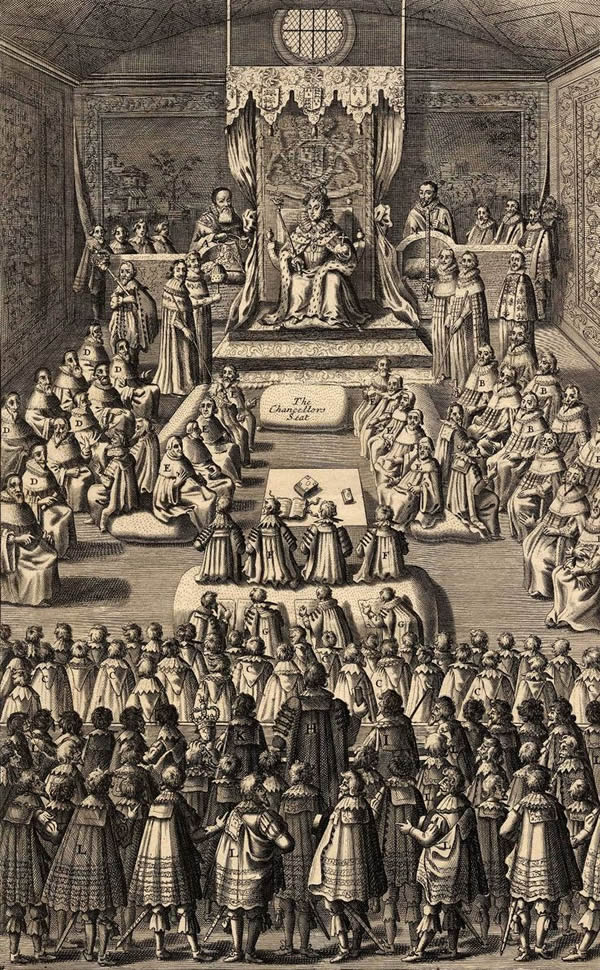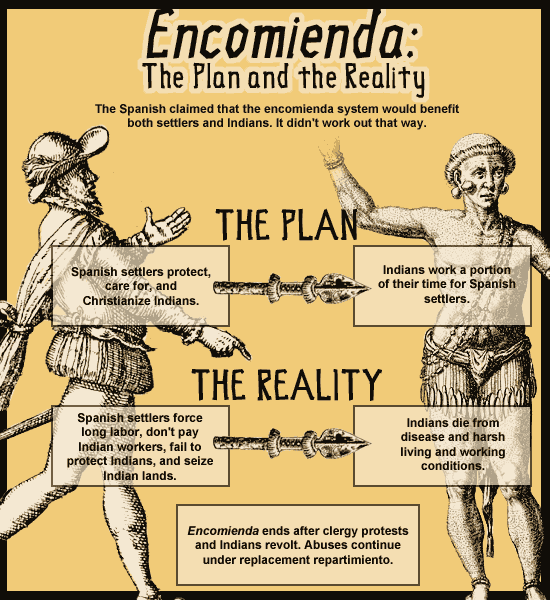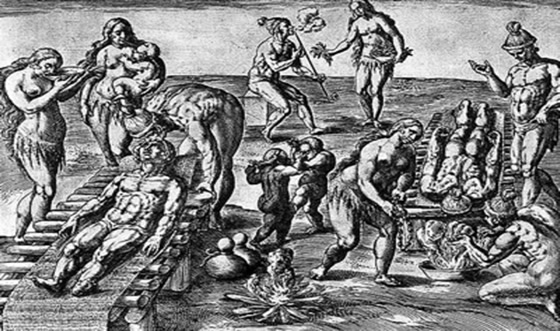The European encounter with the Americas after 1491 set in motion a demographic catastrophe among indigenous peoples across the hemisphere, specifically epidemic and pandemic diseases against which native peoples had no biological immunities, and a crucial component of the larger Columbian exchange between the Old World and New.
The precise characteristics and magnitude of this catastrophe remain a matter of scholarly debate. Population estimates for the Americas on the eve of the encounter vary widely. The most reputable estimates fall between 40 and 100 million for the hemisphere as a whole, a population reduced by an estimated overall average of 75 to 95 percent after the first 150 years of contact, with tremendous variations in time and
space.
Colonial Latin America and The Circum-Caribbean
Central Mexico is the most intensively studied region regarding the impact of European diseases on indigenous demography. Where in 1520 there lived an estimated 25 million native peoples, in 1620 there lived some 730,000—a decline of 97 percent, attributed overwhelmingly to disease.
Similar catastrophes unfolded across the hemisphere. The most precipitous decline is thought to have occurred in the Caribbean, where the precontact indigenous population of several millions had been all but exterminated by the 1550s.
Such diseases spread rapidly in all directions, preceding and accompanying military incursions, weakening indigenous polities, and facilitating the process of conquest and colonization in the Caribbean, Mexico, the Andes, Brazil, New England, and beyond. This process of demographic catastrophe, an unintended consequence of the European encounter with the Western Hemisphere, affected every aspect of the subsequent history of the Americas.
In the English-speaking world, the predominant view for centuries regarding Indian depopulation in postconquest Spanish America centered on the “Black Legend” of Spanish atrocities, a view most forcefully articulated and propagated by the
Spanish bishop Bartolomé de Las Casas in the 1500s.
By the early 2000s, a scholarly consensus had emerged that the principal cause of indigenous population declines was in fact pandemic and epidemic diseases. The exact sequence and timing varied greatly from place to place. Every locale had its unique history of demographic decline, with periodic outbreaks of various pathogens: smallpox, measles, typhus, influenza, yellow fever, diphtheria, bubonic plague, malaria, and others.
Far and away the deadliest killer was smallpox, the first documented New World outbreak occurring in the Caribbean in 1518. Spanish friars, reporting to King Charles V in January 1519, estimated that the disease had already killed nearly one-third of Hispaniola’s Indians and had spread to Puerto Rico. In these earliest outbreaks, influenza probably accompanied the spread of smallpox.
By the early 1520s, three principal disease vectors, mainly of smallpox and influenza, were spreading rapidly through indigenous populations. One had entered through northern South America near the junction with the Central American isthmus, and by the late 1520s had spread far into the interior along the northern Andes.
The second had entered along the gulf coast of Mexico, from Yucatán to present-day Veracruz, and by mid-1521 was decimating the population of the Aztec capital of Tenochtitlán. By the late 1520s, this second vector had bifurcated, spreading south into Central America and north into western and northern Mexico, where it was poised to sweep farther north.
The third disease vector was launched with the first exploratory expeditions along the
Pacific coast of Central America and Peru, beginning in the early 1520s. By the late 1520s, this third vector had also bifurcated, spreading north through Nicaragua and Guatemala, and in less than a decade racing 3,000 miles south down the Andes, reaching as far as southern Bolivia.
A fourth set of vectors began spreading inland from the Brazilian coast from the beginning of permanent settlements in the early 1550s. By the late 1550s and early 1560s, the epidemics had spread along much of the Brazilian coast and were sweeping into the interior.
Widespread death from disease weakened indigenous polities, engendering profound cultural crises and facilitating processes of conquest and colonization. The most dramatic and extensively documented such instance occurred in Tenochtitlán during the conquest of Mexico, where a major smallpox outbreak coincided with the Spanish invaders’ siege of the island city.
From May to August 1521, as many as 100,000 of the city’s inhabitants succumbed to the disease. The smallpox virus typically enters the victim’s respiratory tract, where it incubates for eight to 10 days, followed by fever and general malaise, then the eruptions of papules, then vesicles, and finally large weeping pustules covering the entire body, followed soon after by death.
Scholars agree that this smallpox epidemic, occurring just as their empire and capital city were under assault by the Spanish and their Indian allies, fatally weakened the Aztec capacity to mount an effective resistance.
A similar if distinctive dynamic is thought to have unfolded before and during the conquest of Peru. Again, the timing of the Spanish invasion could not have been more propitious. Less than a decade before the incursion of Francisco Pizarro in 1532, the vast Inca Empire was in relative tranquility under a unified ruling house.
Around 1525–28, at the height of the Inca Huayna-Capac’s northern campaign against recalcitrant indigenous polities around Quito, an unknown pestilence, probably smallpox, ravaged the northern zones. During this epidemic, the Inca was struck by fever and died.
Spanish chronicler Pedro de Cieza de León recorded that the first outbreak of the disease around Quito killed more than 200,000 people. Other chroniclers offered similar descriptions of a wave of pestilence in the northern districts during this same period.
Huayna Capac’s death set in motion a crisis of dynastic succession and civil war that Pizarro deftly exploited to the Spaniards’ advantage. Contributing to the spread of the disease was the Andean tradition of venerating the mummified corpses, as thousands of indigenous Andeans came into contact with the dead Inca and those who ritually had prepared his body.
During this early period, more politically decentralized zones including the Central American isthmus, the Maya regions, northern South America, and the Brazilian coast and hinterlands were also severely stricken, facilitating Spanish and Portuguese incursions less by exacerbating elite divisions or shattering cosmologies than by the sheer magnitude of the deaths.
Almost everywhere that Europeans intruded, indigenous polities, societies, and cultures became profoundly weakened by maladies with no precedent and no cure, as emphasized repeatedly in scores of locales by a diversity of Spanish, mestizo, and indigenous chroniclers.
The second major pandemic to sweep large parts of the Americas was measles, beginning in the early 1530s. From the Caribbean islands the pathogen quickly spread to Mesoamerica, South America, and
Florida, causing mortality rates estimated at 25–30 percent. Outbreaks of bubonic and pneumonic plague began erupting around the same time.
In the mid-1540s, came another series of waves of epidemics across large parts of Mesoamerica and the Andes. The precise bacterial or viral agents responsible for the “great sickness” that swept Central Mexico in the 1540s remain the subject of debate, though the evidence suggests typhus, pulmonary plague, mumps, dysentery, or combinations of these.
There is little disagreement that the death rates thus generated were extremely high, as upward of a million natives in New Spain succumbed to the collection of epidemic diseases in the 1540s. By this time, bubonic plague, typhus, and other pathogens had spread to the Pueblo Indians in the Southwest and to Florida.
The spread of epidemic diseases swept inland from Florida beginning in the 1520s and perhaps earlier. The odyssey of Álvar Núñez Cabeza de Vaca and his small party of shipwreck survivors across the U.S. South and Southwest (1528–37) is thought to have introduced numerous diseases to the native inhabitants.
In particular, the expedition of Hernando De Soto from Florida through the North American Southeast to the Mississippi River Valley (1538–42) is believed to have wreaked tremendous ecological damage, introducing previously unknown pathogens across large parts of the interior.
By the time of sustained European encounters with these regions, beginning in the 1680s, the dense populations and many towns and settlements described by De Soto more than a century before had vanished, leaving behind a landscape largely denuded of its human inhabitants.
Local and regional studies show endless variations on these more general themes, with wave after wave of epidemic diseases wreaking demographic havoc for centuries after the initial encounter. In Brazil, the creation of numerous disease vectors along the coast from the 1550s to the 1650s, diseases often carried by African slaves, generated repeated epidemics of smallpox, typhus, and other pathogens that dramatically reduced populations in the interior.
The disease chronology of northwestern Mexico in the first half of the 17th century illustrates the more general pattern of repeated outbreaks, which in this case were recorded in 1601–02, 1606–07, 1612–15, 1616–17, 1619–20, 1623–25, 1636–41, 1645–47, and 1652–53.
In his classic study of the postconquest Valley of Mexico, Charles Gibson recorded major disease outbreaks every few years, with 50 major epidemics from 1521 to 1810, an average of a major epidemic every six years.
Colonial North America
The Pilgrims in
Massachusetts and the first Europeans to settle on the coast of Maryland and Virginia found a nearly empty country. Almost nine-tenths of the former Native American populations had been wiped out by smallpox in an epidemic of 1618–19.
John Winthrop, the leader of colonial Massachusetts, commented in 1684: “For the native, they are neere all dead of the small Poxe, so as the Lord hathe cleared our title to what we possess.” This Puritan leader and others felt that this disease was God’s plan to make land available for Europeans by eliminating the Native Americans who had previously occupied it.
Smallpox followed the priests, explorers, traders, soldiers, and settlers from Europe into the heartland of the North American continent. The Hurons were affected in 1640, the Iroquois in 1662. In British North America, smallpox indirectly promoted the growth of institutions of higher
learning. Wealthy colonial families sent their sons to England to educate them.
Many of these young men, born in North America, did not have the immunity to smallpox their fellow students in England possessed. Enough of these young men from the colonies contracted and died from smallpox while being educated in Europe that colonial North Americans founded their own colleges, including Harvard, William & Mary, and Yale.
In some cases, smallpox was spread to North American indigenous peoples intentionally, as a form of germ warfare. During the American Revolution, American troops were victims of the disease during a campaign in
Quebec. George Washington successfully had the susceptible American troops inoculated. British troops, who had grown up in England and Ireland, had immunity to the disease.
By the time George Vancouver explored the Pacific coasts of what would become Washington State and the Province of British Columbia, he found entire villages of Native Americas in ruins and deserted with skeletons lying all around. By the 20th century, smallpox had wiped out as much as 90 percent of the preconquest Native American population.
In sum, the impact of hitherto unknown European diseases on indigenous societies unleashed a demographic cataclysm across the Western Hemisphere, representing one of the most important chapters in the history of the postconquest Americas, whose characteristics and impacts scholars are still grappling to comprehend.


































